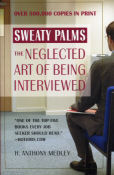| What REALLY goes on in a job interview? Find out in the new revision of "Sweaty Palms: The Neglected Art of Being Interviewed" (Warner Books) by Tony Medley, updated for the world of the Internet . Over 500,000 copies in print and the only book on the job interview written by an experienced interviewer, one who has conducted thousands of interviews. This is the truth, not the ivory tower speculations of those who write but have no actual experience. "One of the top five books every job seeker should read," says Hotjobs.com. | |
|
Tristan & Isolde (7/10) by Tony Medley Position wanted: Editor. Deficiencies: I don’t know how to operate any of the equipment Qualifications: In the past decade I have seen what seems like 2,000 films and 99% of them were too long. Modus Operandi: I have a pair of scissors and I will cut unmercifully. I won’t be influenced by the director’s ego. Alas, I’m too late to save “Tristan & Isolde.” I actually enjoyed the film. Unfortunately, however, many in the audience were laughing at lines that writer Dean Georgaris did not intend as funny. As for me, I didn’t laugh much. I liked the girl, Isolde (Sophia Myles). She’s pretty and a good actress. As for the boy, Tristan (James Franco), the script didn’t give him much acting to do as his character is always pretty morose. He was unable to cry on cue, as was Myles, always a black mark for me. I’ve said it before, but if your actors can’t cry on cue, cut the crying scenes. But, given what he had to work with, Franco came through with a workmanlike performance. I also liked Lord Marke (Rufus Sewell), who becomes Tristan’s putative father. Even though the action takes place in the Dark Ages (the 5th Century), he apparently had one of the first razors that can cut your beard so that it always looks like you haven’t shaved in three days; not two, not four, but three. His beard never varies throughout the film. It doesn’t get longer and it doesn’t get shorter. This is a retelling of the legend of Tristan & Isolde. Amazingly, almost the same story was being acted o’er at about the same time just down the road at Camelot. Tristan equates to Sir Lancelot, Marke to Arthur, and, obviously, Isolde to Guinnevere. The time period has been brilliantly captured. In the old days of Hollywood, when I was growing up, these times were presented in glorious three strip Technicolor. The heroes were beautiful people like Robert Wagner and Robert Taylor and they wore gorgeous clothes and the castles were resplendent. In contrast, one of the best things in this movie is Production Designer Mark Geraghty, who has created realistic landscapes and locations (the west coast of Ireland and the Czech Republic) that could easily have been what they looked like in the 5th Century. The “castles” are just wooden structures, made by unsophisticated people. There are no thrones or crowns or sable capes. The “tournament” is in a dirt patch and is rough and tumble. To its detriment, Kevin Reynolds directs the film without any sense of pace. There is no reason on earth why this story couldn’t have been told in 90 minutes instead of the plodding 126 minutes Reynolds has produced. Despite this, the acting is good all around. The story of star-crossed lovers is always a grabber and Franco and Myles make an attractive couple to present it. There are some bad guys, like Isolde’s old man, who happens to be a king in Ireland who likes to raid and kill the English (or Saxons or whatever they were in the 5th Century). Even though it’s too long and Reynolds still needs to take (and pass) the film school courses on pacing and brevity, I enjoyed this. January 11, 2006 |
|
|
|
|
